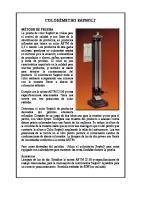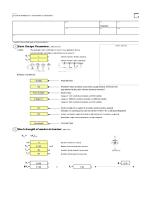Eye Bolt Examples PDF
Example Load and Rigging Calculations This example provides the basic steps for performing load and rigging calculations
Views 61 Downloads 0 File size 111KB
Recommend stories
- Author / Uploaded
- Mauricio Bulla Valencia
Citation preview
Example Load and Rigging Calculations This example provides the basic steps for performing load and rigging calculations. Bob’s Rigging & Crane Handbook (latest edition) or equivalent handbook should be used as reference. 1. Determine the total weight of the load and rigging through: a. Documents, shipping labels, name plate b. Information from a qualified person (engineer, designer) c. Weigh the load d. Calculate the load 2. Determine the required working load limit (WLL) of the crane/hoist. The WLL of the weakest component must be sufficient to handle the load and associated rigging. a. Determine the WLL of all hoist components and b. Verify that the WLL is sufficient 3. Determine the WLL for all rigging components. Example Problem: A container filled with seawater is to be hoisted. Determine the following based on the diagram below: a. The weight of the container of seawater b. The load on each of the sling legs c. The size and type of eye bolt to be used
Page 1
August 2011, Rev. 1
Calculating the weight of the container: Length (L) x Width (W) x Height (H) x Density = Weight. The average density of seawater was determined to be 64 pounds per cubic foot. If uncertain, always verify density and other factors or calculations with a knowledgeable/competent person. 3’ x 3’ x 2’ x 64 lbs/ft3 = 18 ft3 x 64 lbs/ft3 = 1,152 lbs. Calculating the load on each of the sling legs: The vertical load for each sling = number of legs divided by the weight of the container 1,152 lbs divided by 3 legs* = Vertical load for each sling = 384 lbs
* Use 3 legs for the load calculation. One leg is generally balancing the load and cannot be used in load calculations.
Calculating the tension in each sling leg: 1/sin 450 x vertical load = sling tension. 1.414 x 384 lbs = 543 lbs The tension in each sling leg is 543 lbs. NOTE: calculate sling tension using 1/sin of angle or use “Load Sling Factor” from the applicable table in Bob’s Rigging & Crane Handbook.
Page 2
August 2011, Rev. 1
Determining the size and type of eye bolt. Always use forged, shoulder-type eye bolt for angular lifts. De-rate eye bolt according to table: For 450, the factor is 0.3 Direction of Pull
Adjusted Working Load Limit (WLL)
45 Degrees
30% of WLL
90 Degrees
25% of WLL
Page 179 Bob’s Rigging & Crane Handbook
Direction of pull = 450; therefore, de-rate eye bolt to 30% of WLL. From Table 1, select an eye bolt where 0.3 x WLL is greater than 543 lbs. From Table 1 Forged Eye Bolt Size (inches) 1/4
Working Load Limit (lbs) 500
5/16
800
3/8
1,200
1/2
2,200
5/8
3,500
A ½ inch forged shoulder type eye bolt is the best choice. 0.3 x 2,200 = 660 lbs, which is >543 lbs.
Page 179 Bob’s Rigging & Crane Handbook
Rules of thumb: • Never rig below 300, which doubles the sling tension • 450 or higher is preferred • 600 is good • 900 is best
Contact: EH&S Office, x3347.
Page 3
August 2011, Rev. 1









